Translate this page:

106th Trans Bn History

106th Trans Bn History

INTRODUCTION
Constituted 25 February 1943 in the Army of The United States as HHD, 2ND
Battalion, 552nd Quartermaster Truck Regiment, activated 15 April 1943 at
Fort Dix, NJ
Reorganized and Redesignated 20 November 1943 as HHD 106TH Quartermaster
Battalion (Mobile)
Inactivated 22 February 1946 in Munich Germany. Converted and Redisgnated
1 August 1946 as HHD 106TH Transportation Corps Truck Battalion.
The 106th Transportation Battalion is now and always has been a
battalion with a great vitality of spirit and a deep sense of pride in
successful mission accomplishment. The battalion's soldier's are among
the very best and the busiest in the entire Army. Since the 106th was
reactivated in 1955, its most compelling characteristic has been
decentralized operations. The battalion's companies and trailer transfer
points have been widely dispersed since at least 1958.
Headquarters and Headquarters Company, 106th Transportation Battalion
(Truck)(Army) was activated at Landes de Bussac, France on 18 March 1955.
The battalion was formed by transferring personnel and equipment from the
Army Reserve unit 806th Trans Bn, which was concurrently inactivated
(released from active service) as part of the Army's program to return all
reserve component units (National Guard and Army Reserve) to the United
States that had been activated as part of the Troop Augmentation program
in the early 1950s.
In Nov 1956, the 77th Trans Co (Lt Trk) located at La Rochelle, France was
attached to the 106th.
The 106th has led a nomadic existence since its reactivation. The
battalion headquarters has had four permanentť homes, Bussac, France
(near Bordeaux: 1955 to 1958); Coix Chapeau, France (near La Rochelle:
1958 to 1963); Bremerhaven, Germany: (1963 to 1970); and Ruesselsheim,
Germany: (1970 to 1993); Ft Campbell Ky: (1993 to Present). In addition,
the battalion has had two temporary homes. A significant element of the
headquarters was based in Orleans, France from May 1966 to March 1967,
during Operation FRELOC. The second was in Lee Barracks, Mainz, Germany,
from December 1979 to December 1981, during the renovation of Azbill
Barracks.
Possibly because of the frequent moves, the battalion's records are
nearly nonexistent. The history which follows has been pieced together
like a jigsaw puzzle with many lost pieces. Even though some details
may be missing, the important thing is to capture the spirit and
dedication or the thousands or young men and women who have been in the
106th Transportation Battalion throughout the years. Whether drivers,
mechanics, cooks, clerks or communicators, they are all essential in
providing a first class motor transportation service to the United
States Army, Europe.
We have a sign in the battalion headquarters with pictures of our
current soldier of the month and quarter. The sign says: "Welcome,
soldier, to the 106th Transportation Battalion: The highest mileage
truck battalion in the United States Army. These and many other
dedicated soldiers have gone before you. It is your turn now. Hold your
head high and make your contribution to our tradition."
Obviously, many things have changed since 1955. What certainly has not
changed is the extraordinary dedication with which the soldiers of the
106th Transportation Battalion continue to serve our country.
The 106tb Transportation Battalion
Primus Inter Pares - First Among Equals
The Expediters
106TH TRANSPORTATION BATTALION
CREST
THE FLYING TRUCK WHEEL REPRESENTS TRANSPORTATION BY WHEELED
VEHICLE, WHILE THE SCROLL REPRESENTS THE ROADS OVER WHICH THE UNIT IS
REQUIRED TO OPERATE. THE MOTTO "PRIMUS INTER PARES" (FIRST AMONG
EQUALS) REPRESENTS OUR RECORD OF ACHIEVEMENT HAULING OVER THOSE ROADS IN
COMPARISON WITH SIMILAR ORGANIZATINOS. THE FIVE FLEURS DE LIS DENOTE
THE FIVE CAMPAIGN PARTICIPATION CREDITS OF THE BATTALION IN WWII:
NORMANDY, NORTHERN FRANCE, RHINELAND, CENTRAL EUROPE AND ARDENNES-ALSACE
THE BRICK RED AND YELLOW USED IN THE DISTINCTIVE UNIT INSIGNIA (CREST)
OF THE 106TH TRANSPORTATION BATTALION ARE THE BRANCH OF SERVICE COLOR
FOR THE TRANSPORTAITON CORPS. THE BLACK ENAMEL DISC SIGNIFIES CAMPAIGNS
ON GERMAN SOIL.
THE BEGINNING
The ancestral parent of Headquarters and Headquarters Detachment (HHD),
106th Transportation Battalion is the 522nd Quartermaster Truck
Regiment. The 522nd Quartermaster was constituted on 25 February 1943
and activated 15 April 1943 at Fort Dix, New Jersey.
On 20 November, 1943, the regiment vas broken up. It's elements were
reorganized and redesignated. HBD, 2nd Battalion, 522nd QM Regiment
became HHD, l06th Quartermaster Battalion (Mobile).
The battalion deployed to Europe and received participation credit for
five World War II campaigns: Normandy. Northern France; Rheinland;
Ardennes-Alsace; and Central Europe. The battalion was inactivated in
Munich. Germany on 22 February 1946. While inactive. the unit was
converted and redesignated the l06th Transportation Corps Battalion on 1
August 1946.
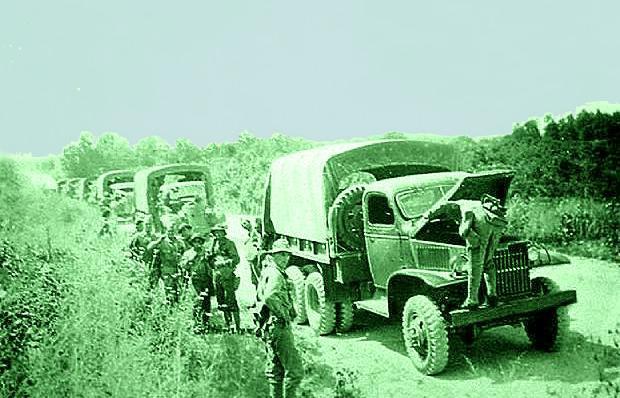
Convoy Maintenance Break During WW2
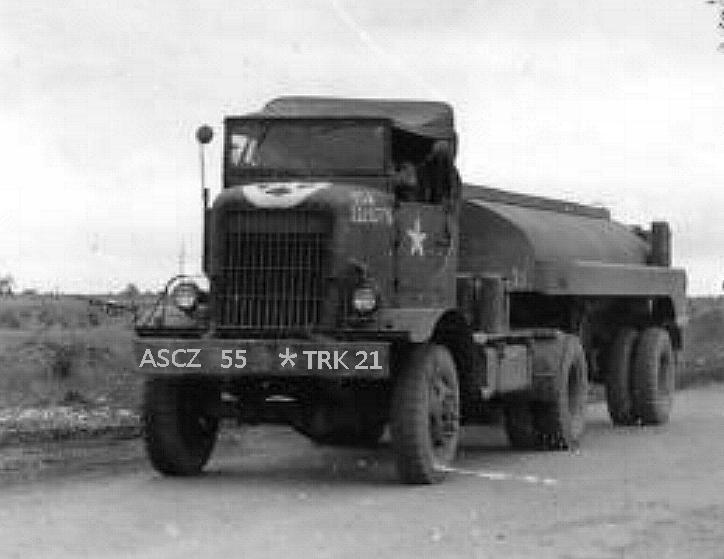
One of the old Autocars from WW2 still used till mid 1950s
EARLY YEARS: 1955 - 1958
After World War II, Russia occupied the East European nations with the
idea of establishing buffer countries between it and the democratic
Europe. The constant threat of war between the Soviet Union and Western
Europe created what was then known as the "Cold War." In preparation
for that the United States and European nations created the North
Atlantic Treaty Organization in April 1949. The US Army established a
comprehensive Communication Zone (COMZ) in France to support the defense
of West Germany from an attack by the Soviet block armies. This COMZ
included a line of communication that stretched from the ports of
Northern France to Germany and supply depots scattered throughout France.
The 106th vas redesignated as Headquarters and Headquarters Company.
106th Transportation Battalion (Truck) (Army) and allocated to the
Regular Army, 1 February 1955. The battalion was activated at Landes de
Bussac (near Bordeaux), France, on 18 March 1955. The early 1950s was
the period of the buildup of the communications zone in France. Several
truck companies were deployed to France as early as 1950. Others came
from the assets of the 37th Highway Transport Command, then located
in Turley Barracks. Mannheim. This was also a period when the World War
II Reserve and National Guard units were being released from active duty
and replaced by Regular Army units.
It is probable that, while no lineal re1ationship exists, the 806th
Transportation Battalion was the forerunner of the l06th in Bussac. The
806th was an Army Reserve batta1ion ca1led into active service in 1951
and deployed to France in late 1952. On 18 March 1955, the 806th
Transportation Battalion was released from active service and reverted
to Army Reserve status at Little Rock, Arkansas. With stmu1taneous
activation/release from active service dates. it is a1most certain that
the l06th assumed the mission, task organization, personnel, equipment
and facilities of the 806th.
Below is one of the 106th Transportation Bn 10 tons belonging to the 595th
Trans Company (Heavy Truck) in 1957. The 595th was located in Braconne
Ordnance Depot France, and had these M123's and 6 of the older M26's Dragon
Wagons, In 1957 the 106th was under the 9th Transportation Group out of
Saran France, which was part of the Red Ball Express of WWll fame.

The Battalion's mission was to clear the port of Bordeaux and line-haul.
into the another battalion's area of operations. The cargo then moved
along the French 1ine of communications into Germany for support of US
Forces there. The next battalion to the east was probably the 28th Trans
Battalion. The battalion's next higher headquarters was the 9th Trans
Group, then located in Saran, France, which later was the 37th Trans Gp.
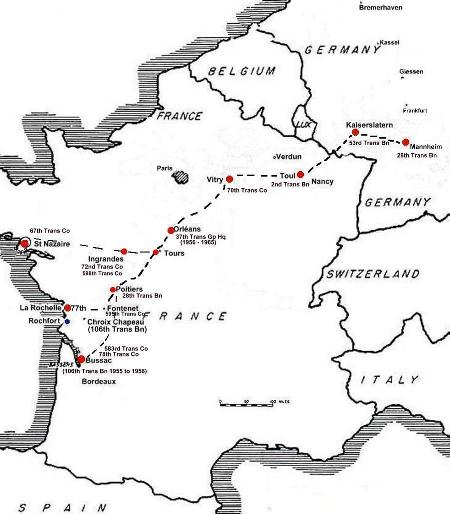
Click for a large Map
Our estimate of the original task organization is based on inferences
drawn from records of the 78th Transportation Company to personal
correspondence and a 1959 battalion yearbook graciously donated to the
l06th in 1983 by Colonel (Retired) Thomas L. Lyons. We gratefully
acknowledge Colonel Lyons' contribution to this portion of our history.
The 55th Transportation Company (Petroleum) was part of the 806th
Transportation Battalion when the 806th was deactived, and the 106th
reactivated in 1955. The 55th remained under the 106th up to 1958.
All During this time, the 55th was in Bussac, but had a platoon in
La Rochelle. It was detached when the Petroleum Command was formed.
The 78th Transportation Company has been with the 106th since the
batta1ion's inception. The 78th was activated on 3 April 1942 as
Company H of the 46th Quartermaster Regiment, Camp Haan, California.
In early 1943, the unit left New York aboard the USS Argentina for
North Africa. In December 1943, the unit was redesignated as the
3488th Quartermaster Truck Company. Inactivated after the war, the
unit vas finally reactivated as the 78th Transportation Company on
21 October 1948 at Camp Kilmer, New Jersey. On 6 September 1951, the
78th was assigned to the 2nd Transportation Battalion, Camp Bussac,
France. It vas reassigned to the 9th Transportation Group on 21
November 1952. On 6 January 1953, the 78th became part of the 806th
Transportation Battalion, and latter part of the 106th Transportation
Battalion. While it is pure guesswork. there was probably also a
trailer transfer point located in Bussac at this time.
The 67th Transportation Company, located in the Chateauroux Air Force
Base complex, was also part of the battalion at this time. The
battalion always had a company with a similar number. Based on
correspondence, it is assumed that the 67th was assigned to the
battalion from 1955 until sometime in 1959, when the 67th moved to the
Port of St Nazaire. Therefore, the initial task organization may have been:
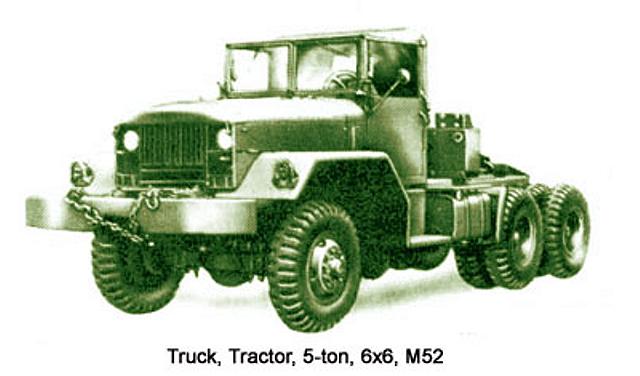
The 106th Used all Tactical Vehicles in the Early Years
HHC, l06th Transportation Battalion, Bussac, France
55th Transportation Company (Medium) (Petroleum), Bussac, France
67th Transportation Company (Medium), Chateuroux Air Force Base France
76th Transportation Company (Medium), Bussac, France
Trailer Transfer Point, Bussac, France
The first battalion commander of the l06th in Bussac was LTC Herbert N. Reed.
Between his assumption of command on 18 March 1955 and LTC Thomas L.
Lyons' assumption of command on 4 January 1959, there were three other
battalion commanders: Major John R. Powell, Major Randall P. Smith and
LTC Marcus A. Petterson. The exact command tenure of each of the first
four battalion commanders is unknown.
Fall, 1956, was a time of change for the battalion. The 9th
Transportation Group became part of the 37th Transportation Highway
Transport Command on 1 October 1956 and moved from Saran to Nancy on
that date. This marked the first time since World War II that all truck
units in US Army Europe (USAREUR) COMMZ were under the jurisdiction of a
single command the (37th THTC). The 9th's mission was to operate the
intersectional highway transport service within the USAREUR COMMZ. On 1
November 1956, the 37th moved from Mannheim, Germany to Orleans, France.
The 2nd Transportation Battalion at Etain and the 106th Transportation
at Bussac were assigned to the 9th Transportation Group on 1 October 1956.
The 77th Transportation Company (Light Truck) was activated on 1 May
1936. Except for a 15 month period, it had been on continuous duty in
North Africa and Europe since arrival in Casablanca, French Morocco in
1943. In November 1950, the 77th deployed from Germany to Bordeaux,
France. In France, they were attached successively to the 771lth
Provisional Truck Battalion, the 109th Transportation Battalion (Truck),
the 2nd Transportation Battalion (Truck) and, in November 1956, to the
106th Transportation Battalion, the 77th was 1ocated in Jeumont Kaserne,
La Rochelle, France.
TASK ORGANIZATION
PRE 1958
The 583rd Transportation Company (Light Truck) was originally
constituted in May 1936, activated in 1942 at Fort Bliss, Texas, and
inactivated 12 April 1950 in Okinawa, Japan. The 583rd was reactivated
on 9 February 1955 at Camp Bussac, France. It was formed with a transfer
of personnel from the 480th Transportation Company, West Virginia
National Guard. The" 583rd was under the operational control of camp
Bussac until 1 October 1956. On that date it was assigned to the l06th.
The 595th Transportation Company (Heavy Truck) was activated at Fort
Jackson, South Carolina on 5 October 1943. The unit arrived in England
on 11 June 1944. It remained in Europe, stationed in both Germany and
France (15 November 1950). The 595th was assigned to the 2nd
Transportation Battalion from 1951 until 1954. When it was redesignated
as a heavy truck company on 3 December 1954, it was assigned directly to
Headquarters, 9th Transportation Group (Truck). On 1 October 1956, the
595th became part of the 106th Transportation Battalion, which was part
of the 9th Group. The 106th would later come under the 37th Group.
Although it is again guesswork, both the 77th and the 583rd probably had
trailer transfer points at this time. They did in 1959. The task
organization in late fall 1956 was as shown:
HHC, l06th Transportation Battalion, Bussac, France
55th Transportation Company (Medium) (Petroleum), Bussac, France
67th Transportation Company (Medium), Chateauroux, France
77th Transportation Company (Light), La. Rochelle, France
78th Transportation Company (Medium), Bussac, France
583rd Transportation Company (Light), Bussac, France
595th Transportation Company (Heavy), Braconne Ordnance Depot, France
Trailer Transfer Point, La Rochelle, France
Trailer Transfer Point, Bussac, France
Other than the 77th Transportation Company, very little is known about
106th activities in 1957. During the year, the 77th Transportation
Company participated in the first test of' the experimental roll-on-roll
off (RO-RO) vessel, the USNS Comet. In October 1957, they rolled 110,000
mi1es in a 15 day period while supporting a logistical support exercise
named LOGSPEC. While not documented, all units of the battalion probably
participated in the series of new off-shore discharge exercises (NODEX)
which were taking place along the coast of France at the time.
The organization of the 106th Trans Bn in 1958 was as follows:
UNIT DESIGNATION DUTY STATION COMMENTS
HHD, 106th Trans Trk Bn Bussac
67th Trans Co (M-S&P) Chateauroux, Fr.
72nd Trans Co (Lt) Ingrandes, Fr.
77th Trans Co (Lt) La Rochelle, Fr.
78th Trans Co (M-S&P) Bussac, Fr.
583rd Trans Co (Lt) Bussac, Fr.
595th Trans Co (Hvy Lift) Fontenet, Fr.
During 1958, the 77th ran more than one million miles. On 30 May, the
595th moved from Braconne to Fontenet, France.
In July 1958, the battalion commander, LTC Petterson, was notified that
the 106th was leaving its home in Camp Bussac and moving north to Croix
Chapeau Medical Installation, in the vicinity of La Rochelle. Croix
Chapeau was a fairly new 500-bed hospital, of which only 50 beds were
used to support the Army in Southwestern France. The move began on 5
August. The 72nd, 78th and 583rd Companies moved as well; but not north. In
July 1958, these units were alerted for deployment to Lebanon. They
convoyed to La Pallice and sailed aboard the USS General George M.
Randall on 27 July 1958.
During the Lebanon crisis, these units were attached to the 201st
Logistica1 Command (A), American Land Forces, Midd1e East. They arrived
in Lebanon on 3 August. On 9 August, the 78th moved to Adana, Turkey (in
the vicinity of the present Incir1ik Air Base). They were further
attached to the 38th Transportation Batta1ion, Adana Sub-Command. It is
not certain, but the 583rd probably remained in Lebanon during the
entire time of deployment.
When the crisis ended, thes units returned to the 106th. The 78th
arrived in France to find that it had a new home. They arrived in Croix
Chapeau on 23 October 1958. The 583rd arrived back in Camp Bussac
(Bordeaux) on 1 November 1958. The 72nd returned to Nancy France, then
latter to Toul.
Thus, by late 1958, the l06th had begun it's long history of wide
dispersion and decentralized operations. It has now been a quarter of a
century. with no end in sight.
WESTERN FRANCE: 1959 - 1963
Coming from the Army War College via COMMZ Headquarters, LTC (later COL)
Thomas L. Lyons assumed command of the battalion on 4 January 1958. It
was to prove a very busy year.
The mission in 1959 was clearance of the ports of St Nazaire, La
Rochelle and Bordeaux, with subsequent line-haul from the western France
Depot Complex to Orleans. Trailers were relayed by the 28th
Transportation Battalion from Or1eans to Nancy. The 2nd Transportation
Battalion then moved the loads to Kaiserslautern, Germany, where they
were delivered by the 53rd Transportation Battalion.
The battalion moved more than 110,000 tons of cargo; accumulating over 5
million miles in the process. The accident rate was a very low 7.76 per
million miles. Battalion units participated in two exercises in the
NODEX series during the year NODEX 20 and 21. NODEX 21 vas the first
ship-to-ship operational transfer of tow-away and drive-away cargo. The
USNS Comet and the lighter USA John U. D. Page linked stern to stern
while in stream. Vehicles from the l06th then drove from the Page to the
Comet, picked up loads and returned to the Page. When the Page returned
to the beach, the l06th drove to the nearest trailer transfer point.
During 1959, the l06th conducted a three level, Battalion Refresher
Training School for officers, NCOs and enlisted members. The COMMZ
Inspector General rated all l06th units excellent or above. The
battalion rif1e team placed second in the COMMZ competition.
There were also changes to the task organization. Not all the details
are clear, but the 68th Transportation Company (Medium) was pulled from
Germany to replace the 72nd Trans Co that was sent to Lebanon.The 68th
was based at Ingrandes and the Ingrandes TTP were attached to the
l06th during 1959. The 1959 year book does not mention the 67th or 72nd
as being part of the battalion. Presumably, because of their close
proximity in Ingrandes and Chateauroux, the OPCON of the 68th and 67th
vas changed at the time of the 68th coming into the battalion and the
67th leaving. The 72nd and the 67th, along with the 583rd were part of
the Lebanon task forces in the summer of 1958. Upon returning to France,
the 67th was in St. Nazaire and the 72nd Trans Company was assigned to
the 53rd Trans Bn in Toul France. The 583rd returned to Bussac France.
In a separate 1etter. COL Lyons stated that he had moved the 67th to
St Nazaire to accommodate the Comet RORO mission. The Comet shifted from
a series of tests to a permanent port of cal1 at St Nazaire on 5 February
1959.
The battalion also constituted a TTP at St Nazaire where 18 RO-RO
operations were conducted during the year. It is guesswork, but the
chronological order vas probably creation of the St Nazaire TTP, switch
of the 68th and 67th and. late in the year as the workload grew,
regaining and moving the 67th to St. Nazaire 68th was probably detached
from the battalion when the 67th moved back to St Nazaire. In a separate
move the 595th moved from Braconne to Rochefort sometime during the year.
TASK ORGANIZATION
1959
The task organization at the end of 1959 was:
HHC (redesignated HHD on 19 June 1959), Chroix Chapeau, France
68th Transportation Company (Medium), St Nazaire
77th Transportation Company (Light), La Rochelle
78th Transportation Company (Medium), Croix Chapeau
583rd Transportation Company (Light), Bussac
595th Transportation Company (Heavy), Rochefort
TTP (67th), St Nazaire
TTP (77th), La Pallice (vicinity of La Rochelle)
TTP (583rd), Bussac
During this period, the 67th, 68th and 78th had five-ton tractors and
ten-ton semi-trailers. The two light companies (77th and 583rd) had 2
1/2s. The 595th was equipped with ten-ton tractors and tank retriever
trailers.
On 15 January 1960. LTC (Later BG) Edwin B. Owen assumed command. The
task organization in mid-1961 remained the same:
HHD, Croix Chapeau
67th Transportation Company (Med), St Nazaire
77th Transportation Company (Lt), Jeumont Kaserne, La Rochelle
78th Transportation Company (Med), Croix Chapeau
583rd Transportation Company (Lt), Bussac
595th Transportation Company (Hvy), Rochefort
TTP, La Pa1lice
TTP, St Nazaire
TTP, Bussac
LTC Owen left the 106th on 30 June 1961 to attend the Industrial College
of the Armed Forces in Washington D.C. He was succeeded in command by
LTC Schefte1 on 14 July 1961.
Under LTC Scheftel. the battalion I s primary mission remained
unchanged: port clearance and line-haul to the 28th TTP at Chateauroux.
They were also heavily committed to other activities, such as NODEX.
Roundout (support of Berlin troop build up). and the relocation of
ammunition depots.
The troops had some fun supplying trucks and extras for the filming of
the movie "The Longest Day". There were also good runs to Spain, hauling
rebuilt vehicles from the ordnance depots to the Spanish Army. There
were also occasional support missions for airborne exercises in the
Pyrenees mountains.
During his tenure, LTC Schefte1 gained the 62nd Transportation Company
(Med). The 595th Transportation Company was dep1oyed to Germany in the
Fa11 of 1961. In addition, the 1st Platoon of the 583rd was deployed to
Chateauroux. The rest of the unit remained in Bussac.
TASK ORGANIZATION
1960 - 1965
So the battalion remained widely dispersed, with about 250 miles between
it's furthest elements. The task organization was as shown:
HHD, Croix Chapeau
62nd Transportation Company (Lt), Bussac
67th Transportation Company (Med), St Nazaire
77th Transportation Company (Lt), Jeumont Kaserne, La Rochelle
78th Transportation Company (Med), Croix Chapeau
1/583rd Transportation Company (Lt), Chateauroux
583rd Transportation Company (Lt), Bussac
TTP, La Pallice
TTP, St Bazaire
TTP, Bussac
LTC (later COL) Brown commanded the battalion from 15 July 1962 until 1
July 1963. During this period, and up until November 1963, the
battalion vas closer together than at any time since. Only 150 miles
separated the two operating locations. The battalion had six elements,
located as shown. There is no record or whether the 62nd and 583rd were
assigned to another battalion or inactivated.
HHD, Croix Chapeau
67th Transportation Company (Med), St. Nazaire
77th Transportation Company (Med), La Pallice
78th Transportation Company (Med), Croix Chapeau
TTP 1, La Pallice
TTP 2, St. Nazaire
AU REVOIR FRANCE: 1963
On 24 July 1963, LTC (later MG) Del Mar assumed command. About this time,
the 77th went from Lt to Med Truck, and picked up 5 Ton trucks. In the fall
of 1963, French President Charles DeGualle ordered American troops out of
his country. On 2 November 1963 the battalion received its orders to
leave western France. Letter orders 241-1. Headquarters COMMZ Europe
dated 2 November 1963, moved the battalion to Bremerhaven. Germany. In
the haste to move, the Army did not have time to approve funds for the
move. LTC Del Mar left ahead of his convoys to arrange for government
quarters for his soldiers and purchased food for the families with his
own money. He authorized each bachelor one trailer and each family two
trailers to load and haul their household goods. They loaded Privately
Owned Vehicles (POVs) on trailers and covered them so they would not be
seen. The last M52 tractor to cross the border had a white painted
plywood sign on the back with a green frog and the words, "Never Again
Froggie," written under it. The Americans referred to the French as
"Frogs." Since American soldiers had fought in two wars for the defense
or liberation of France, they felt insulted.
While not stated in the movement orders, the mission was to clear the
Bremerhaven military ocean terminal and line haul to Giessen. The
battalion headquarters and the 78th Transportation Company and
Detachment 2, TTP, La Rochelle, moved from La Rochelle in France, to
Bremerhaven. The 77th Transportation Company moved from La Rochelle to
Kassel military sub-post, Rothwestern AB, Germany. The 67th
Transportation Company and Detachment 1, TTP moved from St. Nazaire to
Bremerhaven. The 598th Transportation Company vas detached from the 28th
Transportation Battalion, attached to the l06th, and moved from
Ingrandes, France to Kassel. and was attached to the 106th in late 1963.
LTC (later COL) Charles T. Forrester, Jr. commanded the battalion from 4
July 1964 until 1 February 1966. In January 1965, the task organization
was as shown:
HHD. Bremerhaven
67th Transportation Company (Med). Bremerhaven
70th Transportation Company (Med). Kassel
77th Transportation Company (Med). Kassel
78th Transportation Company (Med). Bremerhaven
598th Transportation Company (Med). Kassel
TTA. Bremerhaven
TTB. Kassel
TTD. Kassel
Because the M52 5-ton was designed as a tactical vehicle it was not
designed for high speed traffic on highways. This caused a lot of wear
on the vehicles. Instead, the commanders pushed for commercial
tractors. In 1965, 37th Transportation Command turned in their M52
tractors for the International Harvester 205H tractor.
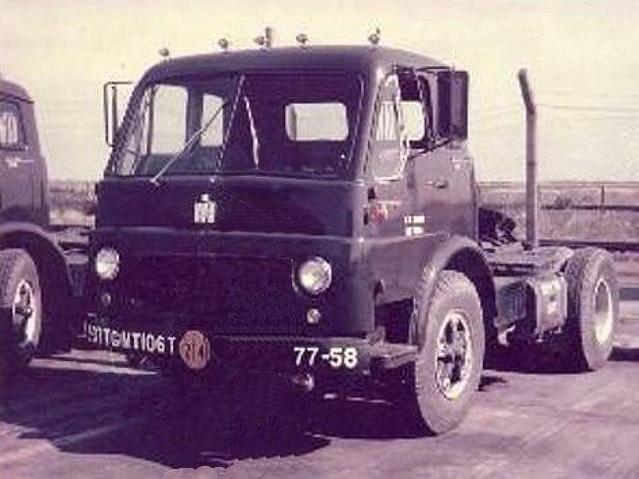
The 106th received IHC DCO 205's to replace the Tactical Vehicles
REVEILLE AT SUNDOWN: MAY 1966 - MARCH 1967
LTC (later COL) Wanek assumed command on 1 February 1966. This was a
bleak time for the battalion. The Army was focusing it's attention on
the Republic of Vietnam. Cargo on the Bremerhaven LOC dropped sharply.
The battalion was rapidly losing drivers as part of Operation Drawdown.
Because so many soldiers were leaving Europe, there was a huge glut of
POVs in Bremerhaven waiting to be shipped home. The 106th was utilizing
only 25% of it's capability. Worse yet, beginning in February 1966, the
106th was committed to provide as many as 120 guards for ammunition
ships arriving in Nordenham, Germany. In addition, POV shuttle details
consumed another 50 soldiers per day. With the 106th becoming an "ash
and trash" battalion, there was speculation that it might be
inactivated. Events proved quite the opposite. The battalion was about
to enter an extremely busy period in it's history. It was a period in
which the 106th again demonstrated it's unparalleled resilience and
productivity in the face of adversity.
In 1965, General de Gaulle and France made the historic decision to
leave the military arm of NATO. This meant, of course, that US Forces
had to leave French soil. The decision was made, not only to withdraw US
Forces, but also to clear all US depots in France. The deadline was set
at 31 March 1967.
In April 1966, LTC Wanek was given the mission to clear the depots in
western France. The initial concept of operation was for the 106th to
clear depots in the general vicinity of Orleans and line-haul to Toul in
the vicinity of Nancy. The code name for the operation vas FRELOC: an
acronym for French Line of Comminations. However, the initial tonnage
figures were seriously underestimated. FRELOC grew geometrically into an
all-consuming monster of men and equipment. During the height of FRELOC,
the l06th ironically found itself clearing it's original home in France:
Bussac General Depot.
To appreciate the enormity of the mission, one must remember that the
battalion retained responsibility for the Bremerhaven-Giessen line of
communication. Even though much of it was deployed in France for 10
months, the battalion headquarters officially remained in Bremerhaven.
Thus, the 106th was responsible for an extra- ordinarily extended line
of communication, stretching from the North Sea port of Bremerhaven to
Captieux, near the Atlantic Ocean port of Bordeaux. There is no way of
knowing whether or not any U.S. Army Battalion ever had such a line of
communication. There certainly can't have been very many.
Like the men of Tennyson' s brigade, the 106th didn't waste time or
effort worrying about the problems; they simply rolled up their sleeves
and got the job done. The cost was high. Three companies, the 70th, 77th
and 598th, were heavily committed to FRELOC for the entire 10 months
operation. Equipment availability was a constant, almost insurmountable,
problem. The problem was exacerbated by the depot' s daytime only duty
hours. Initially, the 106th hauled loaded trailers during the day and
spotted empties during the evening. This meant that trailers stood idle
at the depots' docks all night. The equipment problem became so critical
that LTC Wanek. reversed the duty day. Empties were spotted the first.
thing in the morning for loading. The drivers had "Reveille at Sundown"
and hauled all night.
The 106th operated out of South West France, clearing the depot at Bussac,
and surrounding U S Military facilities including La Rochelle. This is the
106th Staff (Det B )in Bussac in early 1967.
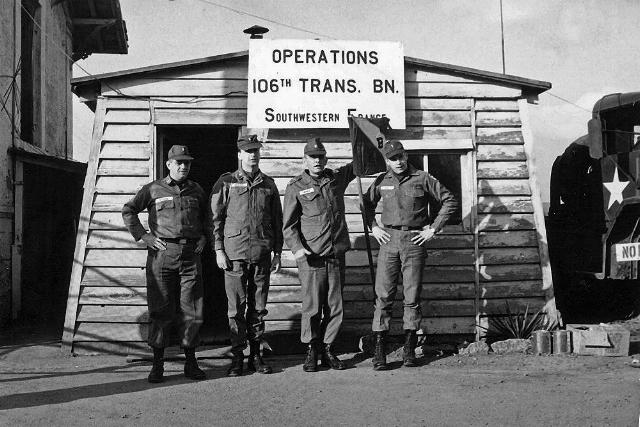
This is the stagging area for the cargo that had to be hauled out of Bussac
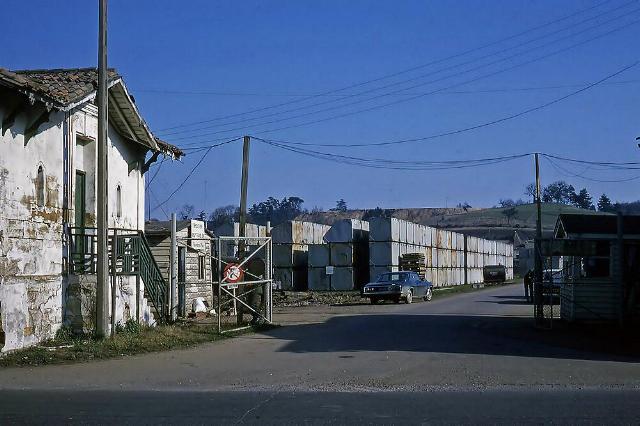
This innovation may have saved the entire operation. It certainly
enabled the 37th Group to have assets available for missions other than
FRELOC. During FRELOC, the battalion accumulated over 6.5 million miles.
Because of it's distinguished accomplishments during FRELOC, the l06th
was given the honor of pulling the last trailer out of France. In
keeping with it's tradition, the l06th accomplished the mission on time
and in good order. The last tractor was driven across the border by SP5
Wilson, 77th Transportation Company, with LT Hefferran as shotgun,
during 'the late evening of' 31 March 1967.
TASK ORGANIZATION
1965
The conclusion of FRELOC brought major changes to the battalion's task
organization. The 900-mile long LOC shifted to a 600 mile long north to
south LOC. The 598th Transportation Company moved from Kassel to
Mannheim in early 1967. With the move, the company was detached from the
battalion and again attached to the 28th in Mannheim. The 1st
Transportation Company and Trailer Transfer Point Hotel (TTH) in
Nuernberg were transferred from the 28th to l06th during the same
period. The 70th Transportation Company moved from Kassel to Butzbach in
support of the Army Depot Complex in Giessen. Upon leaving France, the
77th Transportation Company and TTE were relocated to Dachau, Germany,
near the Austrian border. The battalion headquarters, the 67th, 78th,
TTA and TTB remained in Bremerhaven.
The task organization in the summer of 1967 was as shown:
HBD, Bremerhaven
1st Transportation Company (Med), Nuernberg
67th Transportation Company (Ned), Bremerhaven
70th Transportation Company (Med), Butzbacb
77th Transportation Company (Med), Dacbau
78th Transportation Company (Med), Bremerhaven
TTA, Bremerhaven
TTB, Bremerhaven
TTD, Giessen
TTE, Dachau
TTH, Nuernberg
TURBULENCE IN BREMERHAVEN: 1970 - 1975
By late 1969, a long standing proposal to move the battalion
headquarters to a more central location was approved. In January, 1970
LTC (1ater COL) Conner moved the battalion headquarters and the 78th
Transportation Company to their present home in Azbill Barracks,
Ruesselsheim, Germany (between Frankfurt and Darmstadt).
Azbill Barracks was initially designated as Ruesse1sheim Kaserne. On 12
July 1967, it was redesignated Azbill Barracks in honor of Warrant
Officer Roy Gorden Azbill. Azbill was an Army Aviator who died as a
result of hostile action in the Republic of Vietnam on 10 December 1964.
Azbill was built in 1931. After the war it was used as a school and then
for a civilian labor group unit. Few previous occupants of Azbill are
known. However, in the 1961 - 1968 period it was occupied by HQ's 4th
TRANSCOM and the 501st Transportation Company (Light).
The move left only the 67th Transportation Company and TTA in
Bremerhaven. Two and a half years later the battalion left Bremerhaven
completely. The 67th was inactivated in Bremerhaven on 1 July 1972.
After 17 years, the 67th was no longer part of the battalion.
From 1971 to 1972, the 37th Transportation Command received the newer
model International Harvester Commercial (IHC) tractors 4070 and 2000D
models. The northern most battalion, the 106th, which had the longest
run clearing cargo out of the Port of Bremerhaven received the
IHC4070s. The IHC2000Ds had single axles and could not pull the 20-foot
containers as well.
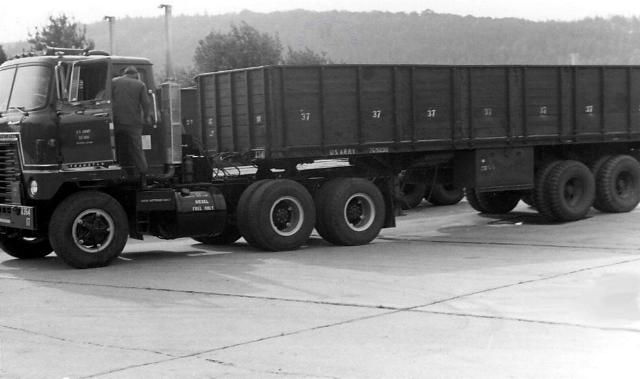
The 106th received these IHC 4070 to better deal with the conditions
Two months later, on 31 August 1972, TTA was attached to the 78th
Transportation Company in Ruesselsheim. Bremerhaven cargo was now
cleared solely by rail.
Sometime after FRELOC. the 70th left Kassel and relocated in Schloss
Kaserne, Butzbach. The unit later moved a few miles north to its present
home on the Giessen Army Depot.
Another long time 106th Company. the 77th left the battalion in the same
time frame. After 27 years of continuous service in the European
theater. the 77th Transportation Company was inactivated in Dachau,
Germany on. 25 June 1970.
TASK ORGANIZATION
1967
By fall of 1972, the task organization was as shown:
HHD, l06th Azbill Barracks, Ruesselsheim
1st Transportation Company (Med), Nuernberg
70th Transportation Company (Med), Giessen
78th Transportation Company (Med), Ruesselsheim
TTA, Ruesselsheim
TTD, Giessen
TTH, Buernberg
The 78th was a light-medium company at this time. They had one platoon
of 2 ½s which they used to support Rhein Main Air Base. Other than Rhein
Main. business must not have been very good. On 1 October 1973, the 3rd
Platoon of the 78th was attached to the 50lst Transportation Company in
Kaiserslautern. This attachment lasted until July 1974. when the 78th
turned in their 2 ½s and again became a medium truck company.
With the withdrawal from the Republic of Vietnam in the early 1970s, the
national attention shifted again to Europe. This meant military highway
assets were again needed in support of Bremerhaven-Giessen LOC.
Initially, these needs were met by taking tractor assets of the TDA
Refrigerator Platoon from the 53rd Transportation Battalion and
assigning them to the l06th. In November 1974, the platoon moved to
Bremerhaven.
Still, as the now of' cargo into Bremerhaven swelled, more assets were
needed in the Bremerhaven area. By early 1975, the TDA platoon had been
augmented to give it a limited maintenance capability. By March 1975,
the battalion was actively looking for a site to reestablish a TTP in
Bremerhaven. By this time, it was obvious that a full company was needed
to service Bremerhaven-Giessen LOC. The 69th Transportation Company in
Mannheim was detached from the 28th Transportation Battalion and
attached to the 106th on 10 September 1975. It moved to Karl Schurz
Kaserne in Bremerhaven. The tractors or the TDA platoon were moved to
Giessen, with the personnel assets reverting to the 37th Group TDA.
The task organization in late 1975 was:
HHD, l06th, Ruesselsheim
1st Transportation Company, Nuernberg
69th Transportation Company, Bremerhaven
70th Transportation Company, G1essen
78th Transportation Company, Ruesse1sheim
TTA. Ruesselsheim
TTB. Bremerhaven
TTD. Giessen
TTH. Nuermberg
TASK ORGANIZATION
1972
ALOC ATTENTION SHIFT SOUTH: 1976 - 1978
By 1975, it had become painfully obvious Azbill Barracks was a terrible
place for a trailer transfer point. It was located in a residential area
far from the autobahn. It also had a very small trailer storage
capacity. Detailed plans were drawn up for a move to Wiesbaden Air Base
as USAF units were withdrawn as part of operation "Creek Swap." The plan
had still not been executed by July of 1976. It is not clear if the exit
move was ever made or if it was overtaken by events.
In January 1977, the Air Line of Communication (ALOC) test program
began. It has continued to grow ever since to where it is now the
battalion's most important task. There are two aerial ports in Germany
which receive air cargo: Ramstein and Rhein Main Air Bases. ALOC cargo
is predominantly repair parts (Class IX) and other high priority cargo
delivered directly to a direct support unit. In November 1977, ALOC
became a permanent DOD Program.
When ALOC was begun as a test program, the decision was made to
establish a temporary TTP on Rhein Main. This created a terrible
facilities problem, from which the TTP still suffers. The TTP was
established without construction of any facilities or hardstand to
support the 200 plus trailers needed to provide daily support to ALOC.
By early 1978, the battalion's task organization was unchanged, except
TTA had moved from Azbill Barracks, Russelshetm, to Rhein Main Air Base.
During the 1978-79 time frame, the 106th units started receiving the
new M915 tractors, and turning in the older IHC Tractors.
From 1978 through 1983 the battalion continued to develop, working the
Trailer Transfer Point concept into a responsive and efficient
transportation system throughout all of the Federal Republic.
The task organization in the fall of 1983 is as shown:
HHD, 106th Transportation Battalion, Ruesselsheim
1st Transportation Company (Med), Nuernberg
69th Transportation Company (Med), Bremerhaven
70th Transportation Company (Med), (5 Squads Med, 1 Squad
Mercedes, 1 Ton Vans), Giessen
78th Transportation Company (Med), Ruesselsheim
15th Transportation Det (TTP), Rhein Main Air Base (Formerly TTA)
152nd Transportation Det (TTP), Nuernberg (Formerly TTH)
326th Transportation Det (TTP), Bremerhaven (Formerly TTB)
517th Transportation Det (TTP), G1essen (Formerly TTD)
TASK ORGANIZATION
1983
The battalion's mission is, as always, to provide theater motor
transportation service to USAREUR. The highest priority task is still
port clearance. Although in 1983, the most important port was the Aerial
Port of' Debarkation at Rhein Main Air Base. ALOC is the
highest-priority, continuing program in the theater. Ninety-nine percent
of' the loads originating at Rhein Main are priority one. The
requirement is within 24 hours from the time of' receipt the battalion
must deliver ALOC Cargo to its customer.
The MTHC Bremerhaven terminal continues to be a major customer,
especially with the Army of the early 1980s in the midst of a
fundamental program of equipment modernization. This program has brought
about a sea change in workload. Workload in the early 1980's moved from
merely very busy to nearly inundated.
The concept of trailer transfer points as pony express relay stations
remains very similar to what it bas been since 1950's. Each company now
has an attached trailer transfer point. This is a significant additional
tasking for each company commander.
One new wrinkle is battalion drivers receive TDY pay. In FY 82 the
battalion TDY payments to drivers were over $565,000. Needless to say,
this shifts a great financial burden from the soldier to the Government,
where it belongs. The crushing emphasis on tons and miles was virtually
eliminated during COL Ross' tenure as the TRANSCOM Commander. The policy
has been continued by his successors, COL Lanzillo and COL Jack Piatak.
There is still an enormous amount of work to be done, however. The
battalion's four companies drove more than 7 million miles in FY 82 and
more than 8 million in FY 83. This battalion's accident rate in mid-1983
was at its lowest ebb ever: 1.22 recordable accidents per million miles.
Since 1981, the 106th has had three overall priorities: becoming expert
in the operation and maintenance of equipment; training; and assigned
soldiers and their families. No matter what else was hot, the fire hose
never shifted from these three fires.
The battalion places a great deal of emphasis on training, both
individual and collective. Soldiers must know survival skills as well as
primary MOS skills. The chain of command has not done its job if its
soldiers cannot survive a night on the perimeter or a chemical attack.
In the fall of 1981, a squad stand down program was begun. Each company
stands down one squad for a week. The battalion directs at least one day
be devoted to vehicular maintenance and one day to NBC operations. The
rest of the week's training is determined by the company chain of
command. All training is conducted by the squad leader.
During the 1981 Christmas holidays, the battalion headquarters moved
back to its newly renovated building at Azbill Barracks in Ruesselsheim.
In 1982, the battalion's strong maintenance program had a real chance to
prove itself. In the USAREUR Excellence in Maintenance Competition, the
70th Transportation Company was the runner-up in V Corps and the 1st
Transportation Company was the VII Corps winner. In July, 1982, the
battalion represented TRANSCOM in the Nijmegen marches. Showing the
"grunts" what truckers could do, the battalion team (under 1LT Keith
Thurgood and SSG Dexter) placed 4th amongst USAERUR' s 52 teams.
The battalion had a very strong showing during the Fiscal Year 82 Annual
General Inspection (AGI). It continued to do well during 1983. So well,
in fact, TRANSCOM paid the unit-the high compliment of canceling our FY
83 AGI.
The battalion's mission problem in the fall of 1983 was to continue
feeding the ever hungry ALOC dragon. The program bas been growing very
rapidly since its inception.
During Operation Vital Link, Ramstein Air Base was closed from 1 May
1983 until 31 July 1983. This meant every ounce of air cargo arriving in
the theater landed at Rhein Main and was cleared by the 106th. While the
burden of the operation fell on the 78th Transportation Company, it was
truly a battalion team effort. Shortly after Operation Vital Link was
completed, the battalion received very heavy taskings for REFORGER 83.
During the deployment phase the 106th was responsible for clearing both
the Duesseldorf (69th) and Rhein Main (78th) APODs. In addition, the
70th Transportation Company was responsible for line haul from Giessen
to the exercise area in the vicinity of Muenster. The battalion was
solely responsible for all truck operations during the redeployment
place. During September 1983, the battalion drove 801,507 miles. This
was the most in any month since operation FRELOC in France in 1967.
During both Vital Link and REFORGER 83, the men and women of the
battalion as they have so many times in the past, proved they could rise
to any occasion and get the job done safely, on time, and in good order.
The year of 1984 brought numerous changes to the battalion both
operationally, with the issuance of the new series M915A1 tractor, and
in terms of unit changes of command, with the battalion receiving a new
commander. Three of the battalion's four line haul companies received
the new M915A1 Tractor as their primary task vehicle. The 1st
Transportation Company, located in Nuernberg, kept the old series
tractor due primarily to the excellent performance record their direct
support maintenance unit enjoyed in reference to vehicle maintenance and
responsiveness. Through Operation "Alley Cat" M915 tractors were swapped
and convoyed to the 1st Transportation Company from the three other
companies. The remainder of the old series tractors were turned in at
depot. At the same time the 69th, 70th, and 78th Transportation Company
received their compliments of the M915A1 series tractor.
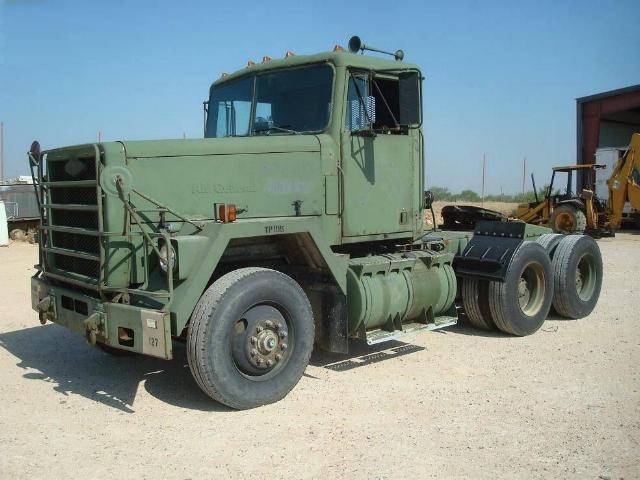
The 106th received these AM General M915A1 Tractors
On 26 June 1984 LTC Zikmund relinquished Battalion Command after three
years to LTC Richard L. Fields. In Aug 84, after the 78th Transportation
Company change of command between 1LT Sharon R. Duffy and CPT Deirdre L.
Dillon, COL Ray Stearns, CDR, 37th Group, presented the 1st Annual
Safety Trophy to the 106th for the safest battalion from July 83-Jun 84.
Operationally, the 70th Transportation Company successfully continued
its unique theater Ammunition Mission, moving CAD's enroute to reaching
2 million accident free miles. As with the 70th, The CDR TRANSCOM, COL
John Piatak, presented the 1st Transportation Company their award for 3
million accident tree miles. Along with this award the 1st
Transportation was also presented the 106th Battalion's Safety Award for
1984. Additionally the 152 Transportation Det (TTPH) received the 4th
TRANSCOM's Maintenance Excellence Award (Light Category.) All companies
successfully accomplished phased Army Training and Evaluation Program
(ARTEP) prior to the year' s end.
Exercise REFORGER 84 challenged the 106th and each of its companies from
Aug - Nov. Held in Northern Germany, the exercise tested the battalion's
ability to pull together and successfully operate as a team. As the
battalion began implementation its Annual "Christmas Mail" mission, 1984
closed out with new challenges and another REFORGER Exercise to deal
with. January 1985 brought REFORGER 85, the termination of "Christmas
Mail" and planning for Wintex 85. All missions which were handled
professionally and responsively. Back to back REFORGER exercises truly
tested the transportation network in USAREUR. The 106th Transportation
Battalion played an integral part in the successes of each. Centered in
Giessen, REFORGER 85 cargo commitments were placed directly on the 70th
Transportation Company and the 517th Transportation Detachment. Meeting
the challenge, the 70th Transportation Company reached 3.5 million
accident free miles and was subsequently nominated from the battalion as
37th Transportation Group's Company of the Year.
In March 85, The battalion began its normal training cycle. The 1st
Transportation Company, successfully planned and executed the first
Military Operations in Urban Terrain (MOUT) ARTEP in 4 years in the
German city of Langenzenn. Deployment of the 152d Transportation
Detachment. on their first ARTEP marked a first. Each company, through
an innovation phased ARTEP program planned and executed individual
exercises using MILES equipment for realism and training. The strict
coordination of mission requirements ensured the battalion 's theater
mission was accomplished.
Another innovative training change implemented in 1985 was the 4th
platoon concept of Army Motor Vehicle Instructors (AMVI's) who were
responsible for training newly assigned 64C' s upon graduation from the
Primus Driver's Academy. This concept centralized training in one
platoon, enhancing it and more effectively utilized training time to
ensure qualified drivers in less time. To date this concept has been
totally successful with proven results in better qualified and safer,
more professional drivers.
All companies changed command during 1985. This change in leadership
established a new group of leaders destined to meet the challenges
offered only to commanders within the 106th Transportation Battalion.
Safety wise, the 69th's new commander CPT Steven Kerr, inherited a
company which broke the 1,000,000 mile accident free miles driven within
his first five days of command.
In training, 1985 found the 69th Transportation Company led by 1LT Doug
McKay, representing the 37th Transportation Group in the Nijmegan
marches in Holland. It was again proven Transporters could successfully
compete with the Army's ground pounders. Successful Berlin Convoys were
conducted by the 69th, 70th, and 1st Transportation Companies throughout
the year. Each exercise ensured the surface corridor remained open for
Allied traffic in addition to rewarding selected soldiers with a well
deserved, unforgettable visit to the island city. Additional new
equipment was issued to the European theater. In addition to the
requirement to deliver most new vehicles to depots for further
deployment, the 106th, itself, received the new CUCV, Which replaced the
Army's standard-the jeep. The Group's trailer fleet was updated with the
M872A3 trailer and the conversion of dropside trailers which increased
the trailer fleet's productivity. Trailer Transfer Points were issued
6,000 and 10,000 pound forklifts for trans-loading cargo. Sponsoring the
37th Group's Annual Truck Rodeo, the 106th ensured it was the best
organized competition ever and then in turn brought home top honors.
International partnership activities saw the battalion participate with
the Dutch in the Queen's Birthday Ball and a separate sports day
competition. The 105th Royal Transportation Battalion was an idea host
for all the activities. Thanksgiving saw local German neighbors of
Azbill Barracks in Ruesselsheim invited to share with the soldiers of as
a gesture of appreciation for continued relations and good will.
REFORGER 86, centered in the Nuernberg area, ushered in 1986 and as in
REFORGER 85 with the 70th Transportation Company, multiplied the work
load for the 1st Transportation Company and the 152d Transportation
Detachment. An unseasonably warm winter turned the exercise into a major
Command Post Exercise (CPX), but the 106th Transportation Battalion
again forged together to meet the challenges through safe and responsive
cargo delivery and mission accomplishment.
Training again took center stage after ENDEX and the 1st Transportation
Company conducted their now routine MOUT ARTEP. The 78th ran the Berlin
Convoy for February 86 coupled with a totally female Convoy making the
Brunson Mail Run to Belgium. Both were excellent training opportunities
to show the US Transportation Corps to international customers. The
issuance of LOGMARS equipment brought the automated world of metal bar
code plates and an innovation cargo documentation/accountability system
for military Cargo. The system will offer maximum benefits once it
becomes totally operational. Another unique milestone for the 78th
Transportation Company came on 14 February, when it hit the 1,000,000
accident free miles driven mark. The remarkable thing about this
achievement is due to its unique mission, the 78th hit the one million
mark 15 miles at a time. As in 1984, 1986 saw the Battalion and two of
its companies change command.
On 26 June, LTC Richard L. Fields relinquished battalion command after
two productive years to LTC Glynne R. Hamrick. Within 30 days of
assuming command, LTC Hamrick received the same award LTC Fields
received during his first days of command - namely the 37th Group's
Safety Trophy as the Safest Battalion from July 85 - June 86. It marked
the 2d time out of 3 years the 106th boasted the safest miles driven in
37th Transportation Group. Two of the battalion's companies continued
their safe driving mileage records throughout 1986 - the 1st
Transportation Company and the 69th Transportation Company both broke
the 3,000,000 mile mark.
CAPSTONE training and interface with the reserves marked 1986 as a
banner new year for new realignment and detailed coordination with
soldiers and units from CONUS. The basic ground work performed during
1986 marked the future a challenging and demanding test for transition
to war and basic Battle Book operational planning.
Heightened terrorist activities throughout Europe caused the
cancellation of nearly all partnership and German - American activities.
Inspite of the threat, one new program initiated in May 85 made it
possible for Azbill Barracks to adopt a local village - Bauschheim.
Activities planned included the local mayor and installation commander
with representation of both organizations enjoying the traditions and
camaraderie of each. A close relationship and pistol range firing with
the Ruesselsheim police department also began during the summer of 86.
With the end of FY 86 came planning and preparation for "Christmas Mail
87". The 106th stood ready to meet its greatest operational challenge yet.
This unit was inactivated on 15 September 1993 in Russelseim, Germany.
FORT CAMPBELL, KENTUCKY
The 106th was reactivated on 18 September 1998 at Fort Campbell,
Kentucky, assigned to the 101st Corps Support Group,101st Airborne
Division
Following the downsizing and reorganization of the US Army in the early
1990s, the 106th transferred to the Fort Campbell, Kentucky. There it
became a part of the 101st Corps Support Group, 101st Airborne Division
(Air Assault).
541st Medium Truck Company (POL)
594th Medium Truck Company (Cargo)
494th Light-Medium Truck Company.
OPERATION IRAQI FREEDOM, 2003
The 106th Transportation Battalion deployed to Kuwait on 19 January 2003
and re-deployed on 12 July 2003. It's mission was to provide theater
transportation support to U.S. and coalition forces during Operation
Enduring and Iraqi Freedom. During the operations the Battalion provided
command and control of the 10th Transportation units consisting of:
* HEADQUARTERS AND HEADQUARTERS DETACHMENT
* THE 68TH TRANSPORTATION COMPANY FROM MANHEIM, GERMANY,
* THE 96TH TRANSPORTATION COMPANY (HETT) FROM FT HOOD, TX,
* THE 109TH TRANSPORTATION COMPANY (MDM) FROM MANHEIM, GERMANY
* THE 126TH TRANSPORTATION COMPANY (PLS) FROM FT BRAGG, NC,
* THE 233RD TRANSPORTATION CO (HET) FROM FT KNOX, BENNING AND FT STEWART
* THE 513TH TRANSPORTATION COMPANY FROM FT LEWIS , WASHINGTON
* THE 567TH TRANSPORTATION COMPANY FROM FT EUSTIS, VA
* THE 594TH TRANSPORTATION COMPANY
* THE 1454TH TRANSPORTATION COMPANY (PLS) FROM CONCORD, NC
At the start of the war the Battalion comprised over 15000 Soldier combat
ready and prepared to liberate Iraq.
Battalion elements crossed the LD during the major combat phase of the
operation at early G + 1. These elements provided the lifeline of supplies
to combat and combat support unit in order to maintain the offensive
towards Baghdad and the destruction of a repressive regime.
The 106th Transportation units delivered supplies and equipment to
destinations such as:
* CAMP BUCCAHA, NEAR UM QASR,
* LSA VIPER
* LSA CEDAR
* TALLIL AIRBASE NEAR AN AN NASRAYI
* LSA BUSHMASTER
* LSA DOGWOOD
* LSA CHESTE
* CSC SCANIA
* BAGHDAD INTERNATIONAL AIRPORT
* BAGHDAD
* FLB RESOLUTE NEAR GARMA
* LSA ANACODA NEAR BALAD
The significant achievements conducted by the Battalion include:
* ACCUMULATION OVER 5 MILLION MILES WITH OUT LOSS OF LIFE OR LIMB
* ESTABLISHMENT OF CONVOY SUPPORT CENTER NAVISTAR WHICH WAS THE
LAUNCHING POINT FOR ALL CONVOYS INTO IRAQ
* PLANNING AND PREPARATION OF CONVOY SUPPORT CENTER CEDAR II NEAR
AN NASIRAYHA IRAQ
In May of 2004 HHD 106th Transportation received orders back to the
CENTCOM area of operation. On 23 Sep 04, the 106th deployed to Kuwait
in support of OIF 2.5 and 04-06. It's mission was to provide theater
line-haul transportation support to U.S. and coalition forces during
Operation Iraqi Freedom. On 15 Oct 04, the Battalion conducted a
transfer of authority ceremony with the 812th Transportation Battalion
and officially took over. During this operation the Battalion provided
command and control of the 10th Transportation units, 2 Trailer
Transfer Detachments, 1 Headquarters Detachment and a Convoy Escort
Platform Company (Provisional)
When the 106th deployed to Kuwait for OIF 04-06 thet drove over 2500
missions and 30 million miles in Iraq. They had one solder killed-in-
action, SGT Jessica Housby and one soldier killed in a vehicle accident,
SPC Anthony Cometa. In addition they killed 26 insurgents, captured
27, and provided route security on ASR Circle.
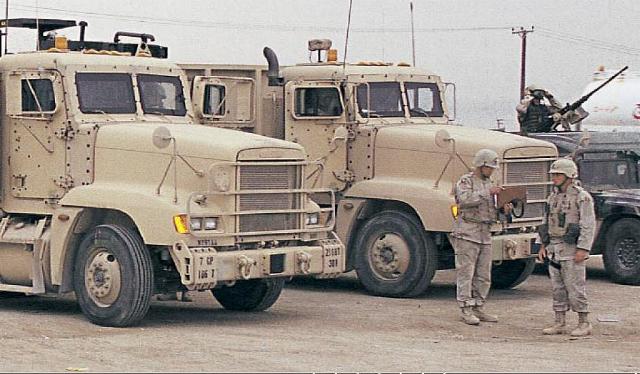
The 106th Transportation Bn in Iraq
with there Freightliner M915A3 Trucks
The 106th Transportation Battalion consisted of:
* HEADQUARTERS AND HEADQUARTERS DETACHMENT FROM FORT CAMPBELL, KY
* 172ND TRANSPORTATION COMPANY FROM OMAHA, NEBRASKA
* 227TH TRANSPORTATION COMPANY FROM ALBERMARIE, NORTH CAROLINA
* 424TH TRANSPORTATION COMPANY FROM GALAX, VIRGINIA
* 483RD TRAILER TRANSFER DETACHMENT FROM FT. BRAGG, NORTH CAROLINA
* 518TH CONVOY ESCORT PLATFORM COMPANY (PROVISIONAL)
(518th Gun Truck Company)
* 591ST TRAILER TRANSFER DETACHMENT FROM CHATTANOOGA, TENNESSEE
* 1075TH TRANSPORTATION COMPANY FROM LINCOLN, NEBRASKA AND THE
NEBRASKA NATIONAL GUARD
* 1450TH TRANSPORTATION COMPANY FROM LENOIR, NORTH CAROLINA AND
THE NORTH CAROLINA NATIONAL GUARD
* 1486TH TRANSPORTATION COMPANY FROM ASHLAND , OHIO AND THE OHIO
NATIONAL GUARD
* 1487TH TRANSPORTATION COMPANY FROM EATON, OHIO AND THE OHIO
NATIONAL GUARD
* 1644TH TRANSPORTATION COMPANY FROM THE ILLINOIS NATIONAL GUARD
* 1864TH TRANSPORTATION COMPANY FROM HENDERSON, NEVADA AND THE
NEVADA NATIONAL GUARD
* 2168TH TRANSPORTATION COMPANY FROM SHELDON, IOWA AND THE IOWA
NATIONAL GUARD
The 106th Transportation Units delivered supplies and equipment
to the following destinations:
* CAMP BUCCAHA, NEAR UM QASR,
* CSC CEDAR
* TALLIL AIRBASE
* LSA BUSHMASTER
* LSA DOGWOOD
* CSC SCANIA
* BAGHDAD INTERNATIONAL AIRPORT
* BAGHDAD
* FLB RESOLUTE NEAR GARMA
* LSA ANACODA NEAR BALAD
* CAMP TAJI
* FOB MAREZ
* FOB WARRIOR
* Q-WEST
* T-Q
* AL-ASAD
* CAMP SMITTY
The Battalion consisted of over 1660 Soldiers during the deployment.
On 12 Sep 05, the 106th Transportation Battalion transferred authority
to the 180th Transportation Battalion at Camp Arifjan, Kuwait.
Campaign Credits:
* NORMANDY
* NORTHERN FRANCE
* ARDENNES-ALSACE
* RHINELAND
* CENTRAL EUROPE
* PARTICIPATION IN:
* OPERATION ENDURING FREEDOM
* OPERATION IRAQI FREEDOM I
* OPERATION IRAQI FREEDOM II
* OPERATION IRAQI FREEDOM 04-06
* OPERATION IRAQI FREEDOM 05-07
Units assigned to the 106th Transportation Bn at Ft Campbell Ky
as of September 2008
541st Transportation Company
594th Transportation Company
372nd Transportation Company
613th Movement Control Team
632nd Movement Control Team
887th Engineering Company
63rd Chemical Company
Headquarter & Headquarters Company
The 106th Transportation Battalion during the Deployment in 2008.
106th Trans Battalion Headquarters at LSA Anaconda, Iraq.
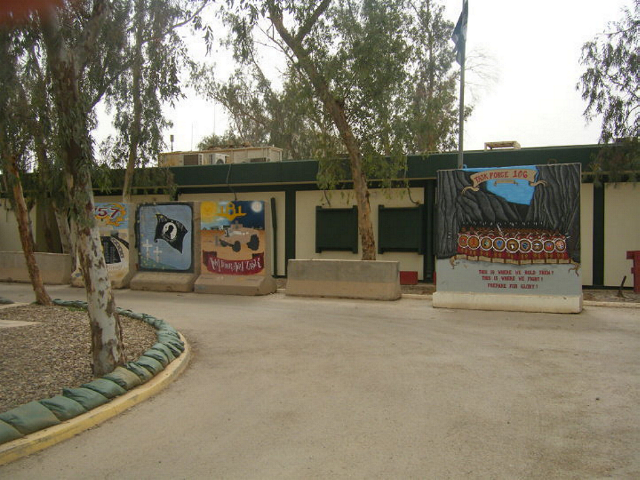
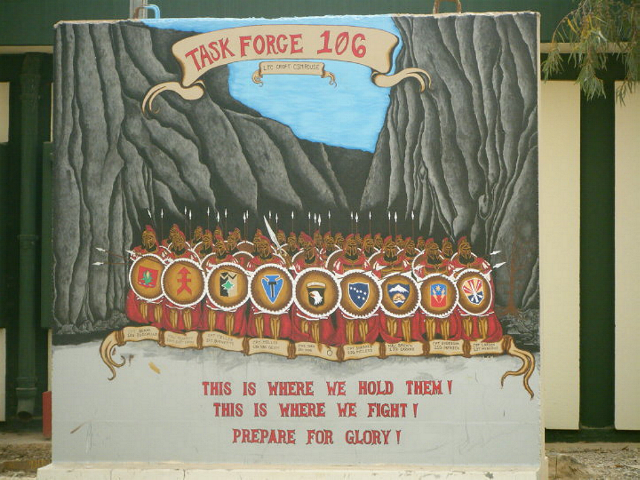

106th TOC
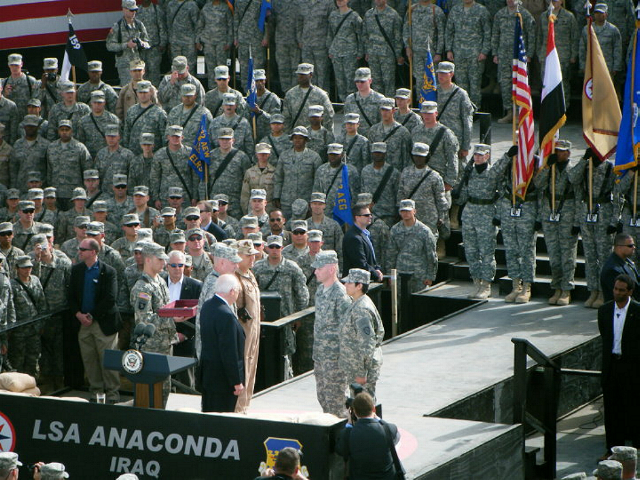
Two 106th Soldiers receive Bronze Stars from VP Dick Cheney
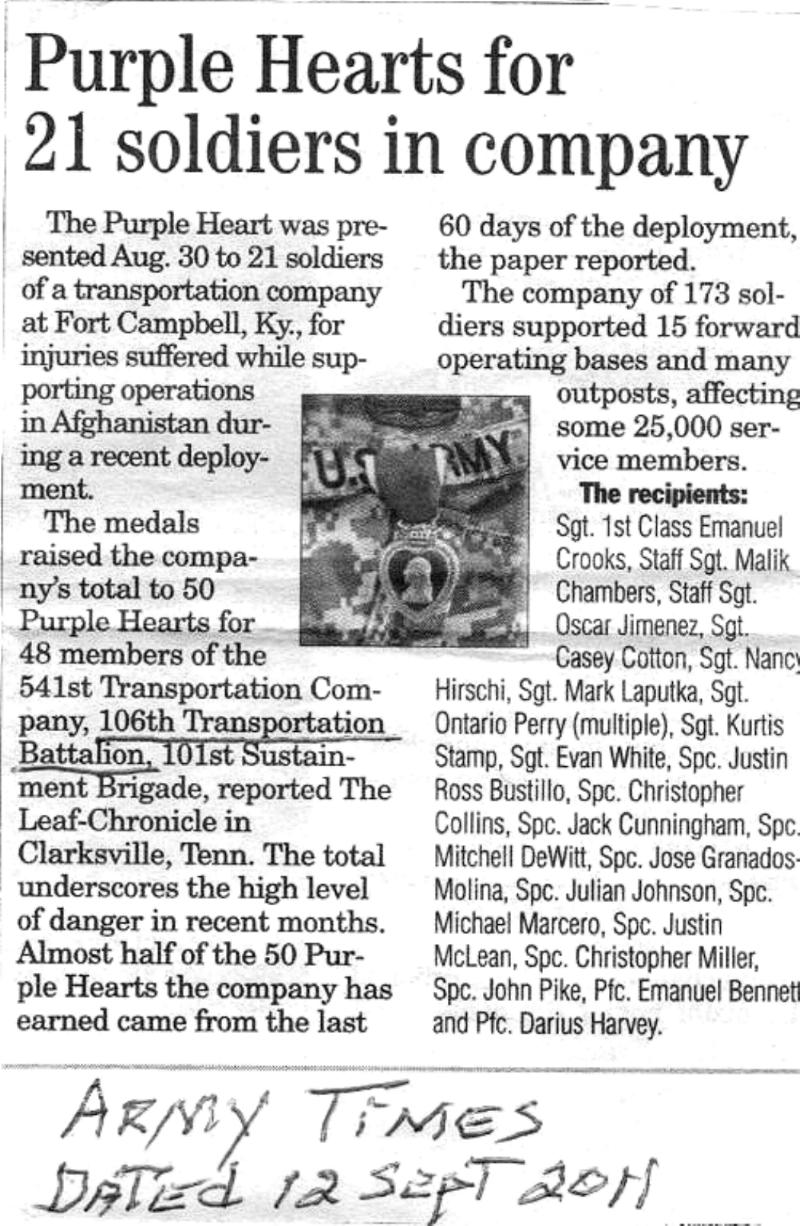
Recent 106th Purple Hearts
COMMANDERS
106TH TRANSPORTATION BATTALION
RANK NAME TENURE
LTC HERBERT N. REED 18 MAR 55 UNKNOWN
(LTC Reed was also the Commander of the 806th when
it was deactivated, and 106th reactivated in 1955)
MAJ JOHN R. POWELL UNKNOWN
MAJ RANDALL P. SMITH UNKNOWN
LTC MARCUS PETTERSON UNKNOWN
LTC THOMAS L. LYONS 03 JAN 59 - 03 JAN60
LTC EDWIN B. OWEN 19 JAN 60 - 30 JUN 61
LTC LAWRENCE SCHEFTEL 14 JUL 61 - 17 JUL 62
LTC VIRGIL G. BROWN 18 JUL 62 - 01 JUL 63
LTC HENRY R. DEL MAR 24 JUL 63 - 03 JUL 64
LTC CHARLES T FORRESTER, JR. 04 JUL 64 - 31 JAN 66
LTC ROBERT F. WANEK 01 FEB 66 - 24 JUL 67
LTC DONALD J. OPITZ 25 JUL 67 - 03 FEB 69
LTC DONALD H. CONNER 04 FEB 69 - 07 AUG 70
LTC WILLIAM H. DANZEISEN, JR. 08 AUG 70 - 08 JUN 72
LTC DAVID G. BAKER 09 JUN 72 - 23 MAY 74
LTC JAMES W. WALLACE 24 MAY 74 - 23 NOV 75
LTC GRADY L. BURLESON 24 NOV 75 - 20 JUN 77
LTC RAYMOND L. STEARNS 21 JUN 77 - 25 MAY 79
LTC ROY C. BERRY 24 JUL 79 - 21 JUN 81
LTC ROBERT L. ZIKMUND 22 JUN 81 - 26 JUN 84
LTC RICHARD L. FIELDS 27 JUN 84 - 25 JUN 86
LTC GLYNNE HAMRICK 26 JUN 86 - 1988
LTC MARK E. VICTORSON 1988 - 1990
LTC MARK E. HARRISON 1990 - 1992
LTC STEVE J. FRAZER 1992 - 1993
The 106th was inactivated on 15 September 1993 in
Russelseim, Germany.
The 106th was reactivated on 18 September 1998 at
Fort Campbell, Kentucky.
LTC Ed Fisher 1998 to 2000
LTC Steve Wilkins 2000 to 2002
LTC Randy Patterson June 02 - July 04
LTC James Sagen July 04 - July 06
LTC Chris Croft July 06 - June 08
LTC Mary Beth Taylor June 08 - July 10
LTC Marc Hamilton July 10 - Sept 11
The 106th Transportation Bn Deactivatd on Sept 15 2011 at Ft Campbell Ky.
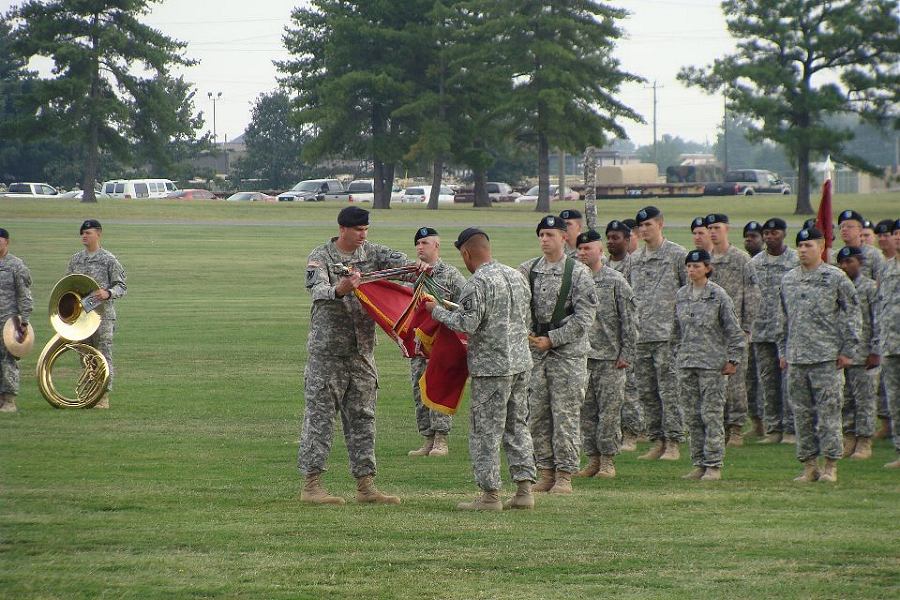

 E Mail to [email protected] if you have added information.
E Mail to [email protected] if you have added information.